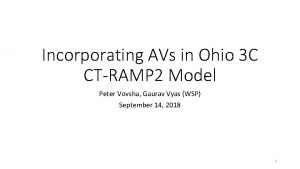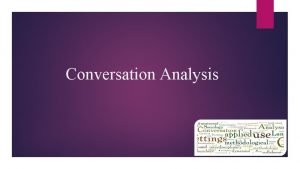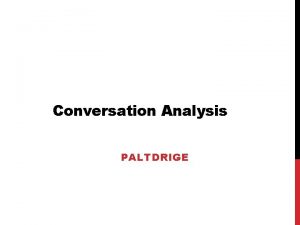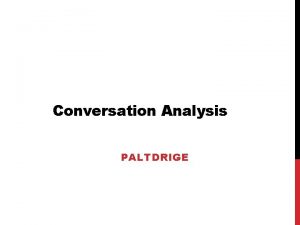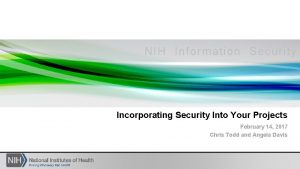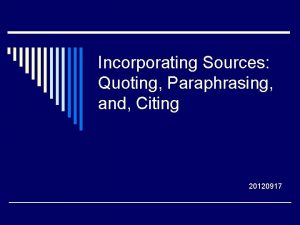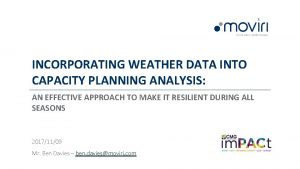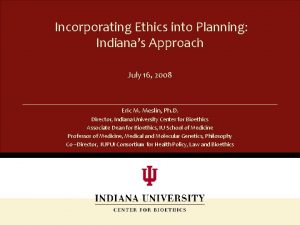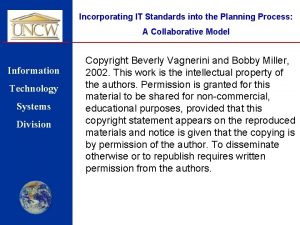Incorporating Social Security Into The Planning Conversation Social



































- Slides: 35

Incorporating Social Security Into The Planning Conversation

Social Security Terms • Full Retirement Age is the age at which you are eligible to receive 100% of your Primary Insurance Amount. It is also the age claimant must be if they want to file strategically.

Social Security Term • The "primary insurance amount" (PIA) is the benefit (before rounding down to next lower whole dollar) a person would receive if he/she elects to begin receiving retirement benefits at his/her normal retirement age.

Social Security Term • Average Indexed Monthly Earnings (AIME) When we compute an insured worker's benefit, we first adjust or "index" his or her earnings to reflect the change in general wage levels that occurred during the worker's years of employment. Such indexation ensures that a worker's future benefits reflect the general rise in the standard of living that occurred during his or her working lifetime. • Key point: best 35 years of earnings are used to calculate AIME.

Social Security Term • Delayed retirement credits (DRCs) are credits we use to increase the amount of your old-age benefit amount. You may earn a credit of 2/3 of 1% for each month during the period beginning with the month you attain full retirement age and ending with the month you attain age 70. The delayed credit is 8% per year for each year delayed.

Social Security Term • Deeming rule: If you file for benefits prior to full retirement age, you are deemed to have filed for all benefits for which you are eligible. A claimant who is entitled to a reduced retirement benefit and a reduced spouse's benefit must file for both benefits if eligibility for both benefits exists in the first month of entitlement. • Key point: Deeming rule does not apply when claiming survivor benefits

Full Retirement Age, when You are Eligible to Receive 100% of PIA Year of Birth * Full Retirement Age 1937 or earlier 65 1938 65 and 2 months 1939 65 and 4 months 1940 65 and 6 months 1941 65 and 8 months 1942 65 and 10 months 1943 --1954 66 1955 66 and 2 months 1956 66 and 4 months 1957 66 and 6 months 1958 66 and 8 months 1959 66 and 10 months 1960 and later 67 *If you were born on January 1 st of any year you should refer to the previous year. (If you were born on the 1 st of the month, we figure your benefit (and your full retirement age) as if your birthday was in the previous month. )

Who is Eligible for Social Security Retirement Benefits • A worker who has accumulated a minimum of 40 work credits (about 10 years work) • Benefit is based on an average of the highest 35 years of earnings in which the worker paid payroll taxes. • The spouse of an eligible worker • An ex-spouse who was married at least 10 years to an eligible worker

PIA Bend Points 0 60 0, 97 $1 , 3 $5 $8 95 – For an individual who first Replacement percentage becomes eligible for old-age 100% insurance benefits or disability insurance benefits in 90% 2018, or who dies in 2018 80% before becoming eligible for 70% benefits, his/her PIA will be 60% the sum of: 50% (a) 90 percent of the first Replacement $895 of his/her average 40% percentage indexed monthly earnings, 30% plus(b) 32 percent of his/her 20% average indexed monthly 10% earnings over $895 and 0% through $5, 397, plus(c) 15 percent of his/her average indexed monthly earnings over $5, 397.

Earliest Filing Age • The earliest age at which you can begin receiving your Social Security retirement benefits is 62*. You can apply for your benefits 3 months before you turn 62 if you want your payments to start at that age. • The reduction is permanent *Survivor benefits can be filed as early as age 60.

The Impact of Waiting Worker Benefits 75% 80% 87% 37. 50% 41. 70% 35. 00% 93% Spousal Benefits 100% 108% 116% 124% 132% 50. 00% 45. 80% 50. 00%50. 00% Filing Age 62 yrs 63 yrs 64 yrs 65 yrs 66 yrs 67 yrs 68 yrs 69 yrs 70 yrs *The percentages for the spousal benefit are based on the primary workers Primary Insurance Amount (benefit at full retirement age)

Bipartisan budget act of 2015 • The new rules dramatically change Social Security claiming options and effectively divide each individual into one of three groups: • People born on or before May 1, 1950 will be the least affected, although if they plan to suspend their retirement benefit and still allow others to collect auxiliary benefits based on their record (i. e. , spousal and child benefits) during suspension, they must request benefit suspension no later than April 29, 2016. • People born between May 2, 1950 and January 1, 1954 will see mixed effects of the new rules on their optimal benefits filing strategy. • People born on or after January 2, 1954 will be the most affected in terms of the effects of filing and suspending as well as not being able to file a restricted application for either just a spousal benefit or just a retirement benefit even after their full retirement age. They will not receive auxiliary benefits during suspension.

SPOUSAL BENEFIT • Even if you have never worked under Social Security, you may be able to get spouse’s retirement benefits if you are at least 62 years of age and your spouse is receiving retirement or disability benefits. • BENEFIT AMOUNT IS 50% OF COVERED WORKERS PIA. COVERED WORKER MUST HAVE FILED FOR BENEFITS BEFORE SPOUSE CAN APPLY. MUST BE MARRIED 12 MONTHS TO BE ELIGIBLE FOR SPOUSAL BENEFIT.

Ex-Spouse Benefit • Married for 10 or more years, divorced for less than 2 years. • NH has to have filed for benefits in order for exspouse benefit to be available. • Ex-spouse benefit does not count toward family maximum

Independently Entitled Ex spouse If you are divorced for 2 or more years, but your marriage lasted 10 years or longer, you can receive benefits on your ex-spouse's record (even if he or she has remarried) if: • You are unmarried; • You are age 62 or older; • Your ex-spouse is entitled to Social Security retirement or disability benefits and • The benefit you are entitled to receive based on your own work is less than the benefit you would receive based on your ex-spouse's work *Key point: This benefit is available provided you have not remarried. •

Survivor Benefit • Your widow or widower can receive: – reduced benefits as early as age 60 or full benefits at full retirement age or older. • If your widow or widower remarries after they reach age 60 (age 50 if disabled), the remarriage will not affect their eligibility for survivors benefits. • MUST BE MARRIED 9 MONTHS TO BE ELIGIBLE FOR SURVIVOR BENEFIT

Survivor Full Retirement Age At age 62 3. a Full (survivors) $1000 Year of Birth 1. Retirement survivors Age 2. benefit would be reduced to Months between age Monthly % 60 and full reduction 4. retirement age 1939 or earlier 65 $829 60 . 475 1940 65 and 2 months $825 62 . 460 1941 65 and 4 months $822 64 . 445 1942 65 and 6 months $819 66 . 432 1943 65 and 8 months $816 68 . 419 1944 65 and 10 months $813 70 . 407 1945 - 1956 66 $810 72 . 396 1957 66 and 2 months $807 74 . 385 1958 66 and 4 months $805 76 . 375 1959 66 and 6 months $803 78 . 365 1960 66 and 8 months $801 80 . 356 1961 66 and 10 months $798 82 . 348 $796 84 . 339 1962 and later 67 • Monthly reduction percentages are approximate due to rounding. The maximum benefit is limited to what the worker would receive if he or she were still alive. Survivors benefits that start at age 60 are always reduced by 28. 50%.

Filing early for Survivor Benefit • The “Deeming Rule” does not apply to a spouse filing for benefits before full retirement age! • A claimant could file for survivor benefit at age 60 and switch to benefit based on his or her own work history at a later date if that benefit is larger. • Or • Claimant could file for reduce benefit at age 62 based on their own work history and switch to survivor benefit at full retirement age.

“Restricted Application” for spousal benefits • The Bipartisan Budget Act of 2015 limits eligibility for this strategy to those who are born January 1, 1954 or prior. • By claiming a restricted application for the spousal benefit upon reaching full retirement age, you can delay receiving benefits based on your own work history and later switch to the potentially higher benefit amount. • If filing before full retirement age the “deeming rule” applies and restricted application is not available.

Restricted application case study • Jim & Jane both age 66 • Jim: Eligible for $2, 000 monthly benefit at age 66 or $2, 640 at age 70 • Jane: Eligible for $1, 600 monthly benefit at age 66 • If both claim benefits at age 66, they could receive a total of $1, 036, 800 over the next 24 years. • If Jane claims her worker benefit at age 66, Jim could claim a restricted application for a spousal benefit of $800 at age 66 and delay his own worker benefit. • Then at age 70, Jim could switch to his own maximum monthly worker benefit of $2, 640 • This strategy could yield a total of $1, 132, 800 over 24 years.

Windfall Elimination Provision and Government Pension Offset • WEP: The Windfall Elimination Provision may affect how we calculate your retirement or disability benefit. If you work for an employer who does not withhold Social Security taxes from your salary, such as a government agency or an employer in another country, any pension you get from that work may reduce your Social Security benefits. • GPO: If you receive a pension from a federal, state, or local government based on work for which you didn’t pay Social Security taxes, we may reduce your Social Security spouses or widowers benefits.

WEP Substantial Earnings

WEP Example • Fred retired from a job that had a social security exempt pension. He will draw pension of $3, 000 per month. Fred worked and paid into social security for 10 years with another employer. • Fred’s AIME for the 10 yrs. is $800. • Normal social security benefits would be $800 x 90%=$720 • Since Fred falls under WEP his social security benefit will be $320 per month $800 x 40%=$320 • WEP does not apply until non-covered pension is received

Government Pension Offset (GPO) • If you receive a pension from a government job in which you did not pay Social Security taxes, some or all of your Social Security spouse's, widow's or widower's benefit may be offset due to receipt of that pension. This offset is referred to as the Government Pension Offset, or GPO. • The GPO will reduce the amount of your Social Security spouse's, widow's or widower's benefits by two-thirds of the amount of your government pension.

GPO Example • Jane is 66 and draws $3, 000 per month in non covered pension. Her husband Jim dies: he was drawing $2, 500 social security benefit based on his work history. • Normally Jane would be eligible as survivor to receive the $2, 500 monthly benefit however due to GPO she will receive $500 survivor benefit. pension x calculation=GPO SS survivor - GPO = survivor benefit benefit • $3, 000 x 2/3=$2000, $2, 500 -$2, 000=$500

Earnings Test • If you are under full retirement age for the entire year, we deduct $1 from your benefit payments for every $2 you earn above the annual limit. For 2018, that limit is $17, 040. • In the year you reach full retirement age, we deduct $1 in benefits for every $3 you earn above a different limit. In 2018, the limit on your earnings is $45, 360 but we only count earnings before the month you reach your full retirement age

Special Earnings Test Rule • Note: If your earnings will be over the limit for the year but you will be retired for part of the year, we have a special rule that applies to earnings for one year. The special rule lets us pay a full Social Security check for any whole month we consider you retired, regardless of your yearly earnings.

Special Earning Test • Filing early annual limit $17, 040 Monthly test limit $1, 420 If you are not going to make more than $1, 420 per month after claiming Social Security benefits you will receive benefits without reduction regardless of how much you made before claiming SS benefits • Filing early annual limit in the year you reach full retirement age $45, 360 • Monthly test Limit $3, 780 • Unlimited income can be earned starting the month you reach full retirement age.

Benefit Reductions who’s affected • When earnings test is applied to NH benefit, NH benefit and all supplemental benefits (spousal, dependent) are impacted. • When earnings test applies to supplemental benefit (spousal benefit) only the supplement benefit is affected.

Will Your Social Security Benefits Be Taxed? Taxable Portion of Benefits 50% 85% Combined Income Single Filer Married Joint Filer $25, 000 to $34, 000 $32, 000 to $44, 000 Over $34, 000 “Combined income” formula used by the IRS: Adjusted gross income + Tax-exempt interest + 50% of Social Security benefits Over $44, 000

Taxable Social Security Total Social Security Benefit Taxable Social Security

What Makes up Provisional Income Provisional income = gross income + tax-free interest + 50% of Social Security benefits + any tax -free fringe benefits and exclusions - adjustments to income

What Is Not considered Provisional Income • Roth IRA distributions • Properly structured Life Insurance Distributions

Will My Social Security Be Taxable Income sources Couple 1 Couple 2 (TIRA) (ROTH) Interest CD’s $2, 000 Stock Dividends $12, 000 Tax free Bonds $6, 000 IRA distribution $25, 000* Social Sec. benefit $22, 000** Total income $67, 000 Provisional income $56, 000 $31, 000 Taxable Social Sec. Up to 85% “ 0” This is a hypothetical example results will vary *Roth IRA distribution is invisible when calculating provisional income. ** 50% of Social Security is used in calculating Provisional income.

Common Confusion Provisional Income that determines taxation of social security benefit 50% of social security Pension income Taxable interest Tax exempt interest Qualified plan distributions (not Roth IRA distributions) • W-2 income • Profit from self employment • • • Earnings Test for early retiree • Earned income (W-2) • Profit from self employment
 Incorporating the change
Incorporating the change Nn
Nn Incorporating quotes
Incorporating quotes Incorporating pronunciation
Incorporating pronunciation Incorporating in ohio
Incorporating in ohio Methods of incorporating risk in capital budgeting
Methods of incorporating risk in capital budgeting Security security security
Security security security Congratulation or congratulations
Congratulation or congratulations Cognitive coaching planning map
Cognitive coaching planning map Hát kết hợp bộ gõ cơ thể
Hát kết hợp bộ gõ cơ thể Frameset trong html5
Frameset trong html5 Bổ thể
Bổ thể Tỉ lệ cơ thể trẻ em
Tỉ lệ cơ thể trẻ em Chó sói
Chó sói Tư thế worms-breton
Tư thế worms-breton Chúa yêu trần thế
Chúa yêu trần thế Môn thể thao bắt đầu bằng từ đua
Môn thể thao bắt đầu bằng từ đua Thế nào là hệ số cao nhất
Thế nào là hệ số cao nhất Các châu lục và đại dương trên thế giới
Các châu lục và đại dương trên thế giới Công của trọng lực
Công của trọng lực Trời xanh đây là của chúng ta thể thơ
Trời xanh đây là của chúng ta thể thơ Mật thư tọa độ 5x5
Mật thư tọa độ 5x5 Làm thế nào để 102-1=99
Làm thế nào để 102-1=99 độ dài liên kết
độ dài liên kết Các châu lục và đại dương trên thế giới
Các châu lục và đại dương trên thế giới Thể thơ truyền thống
Thể thơ truyền thống Quá trình desamine hóa có thể tạo ra
Quá trình desamine hóa có thể tạo ra Một số thể thơ truyền thống
Một số thể thơ truyền thống Cái miệng xinh xinh thế chỉ nói điều hay thôi
Cái miệng xinh xinh thế chỉ nói điều hay thôi Vẽ hình chiếu vuông góc của vật thể sau
Vẽ hình chiếu vuông góc của vật thể sau Thế nào là sự mỏi cơ
Thế nào là sự mỏi cơ đặc điểm cơ thể của người tối cổ
đặc điểm cơ thể của người tối cổ V cc
V cc Vẽ hình chiếu đứng bằng cạnh của vật thể
Vẽ hình chiếu đứng bằng cạnh của vật thể Tia chieu sa te
Tia chieu sa te Thẻ vin
Thẻ vin




